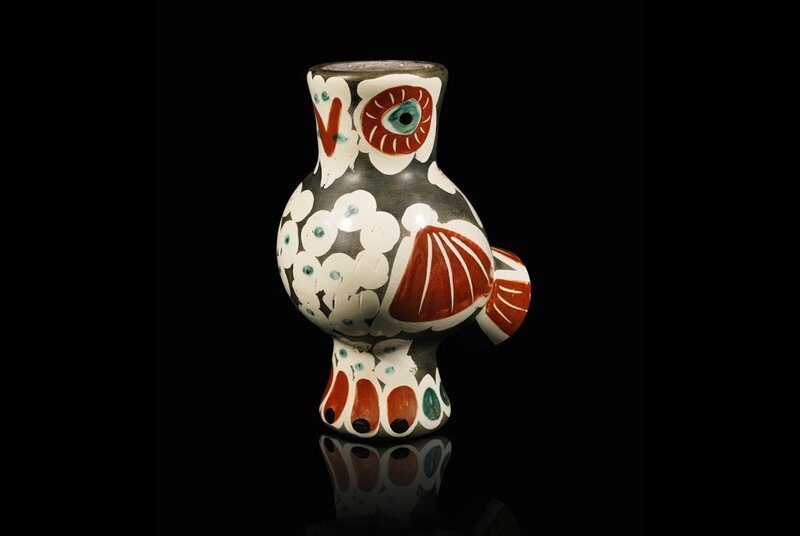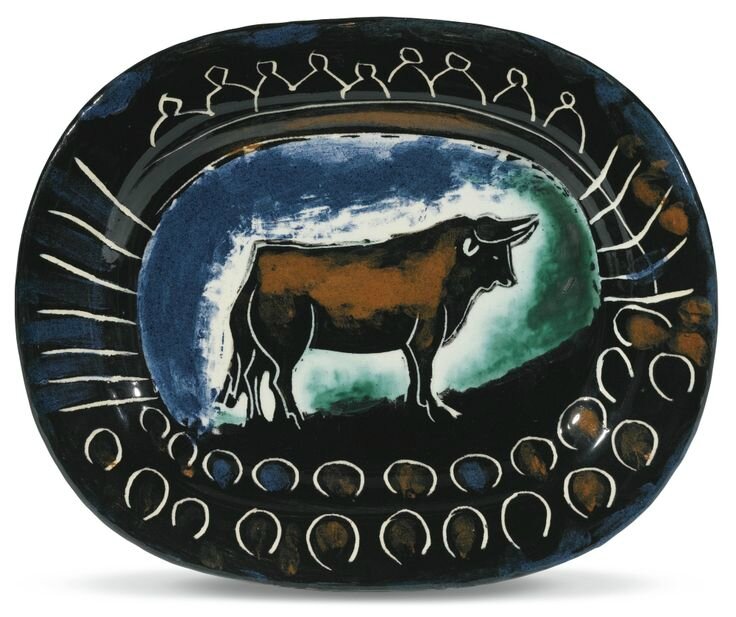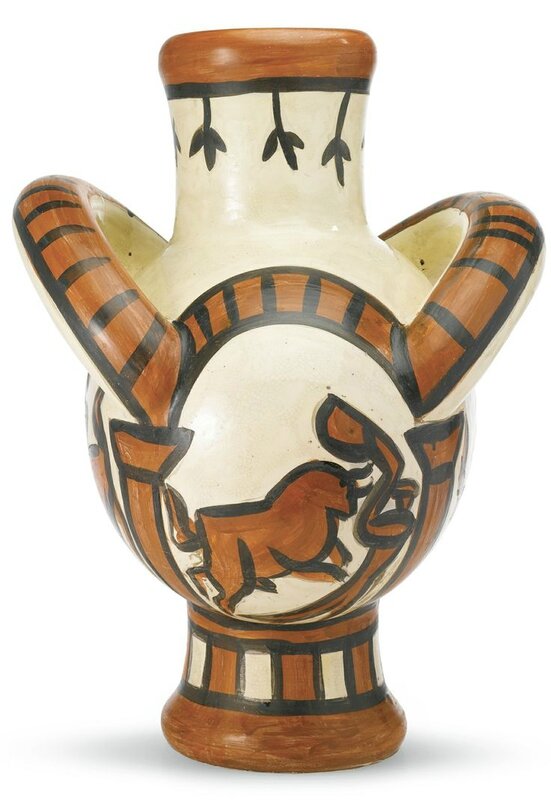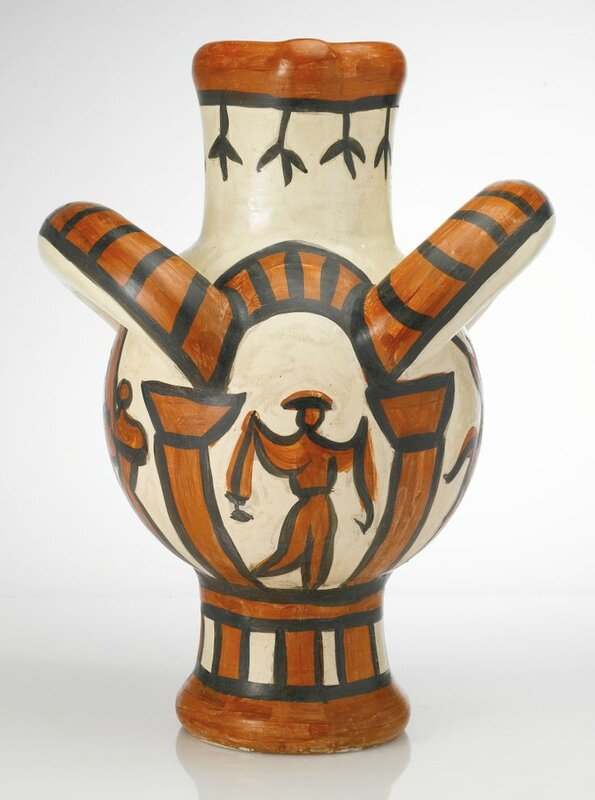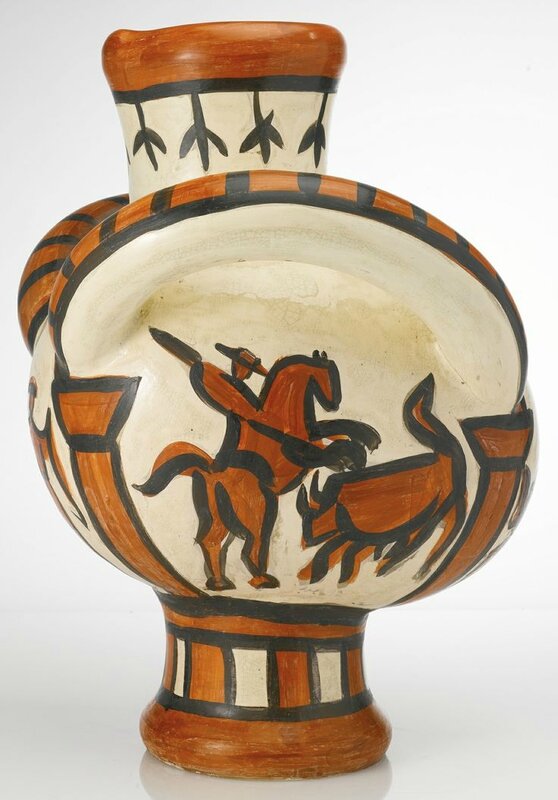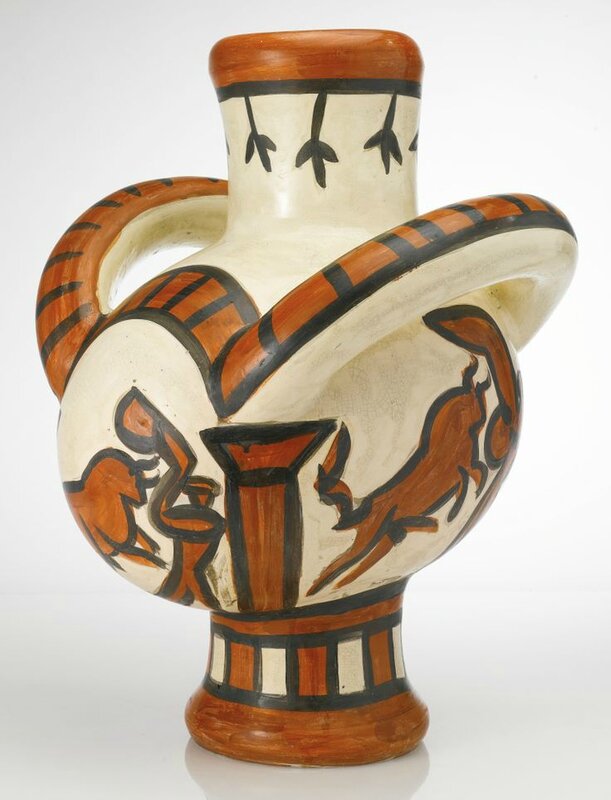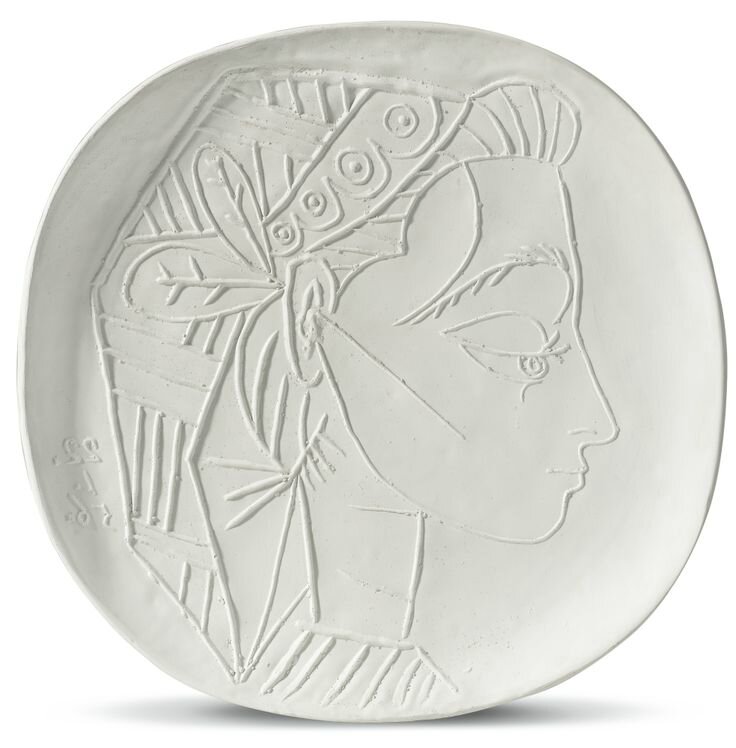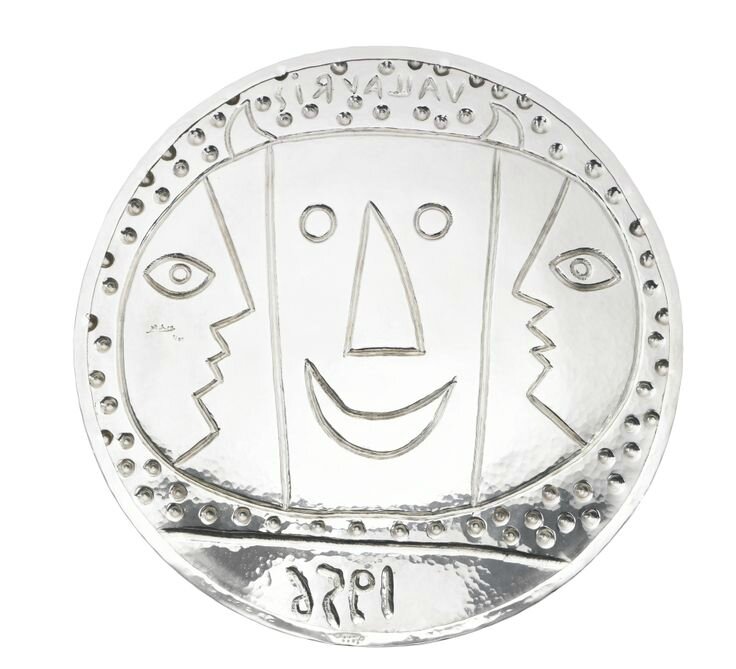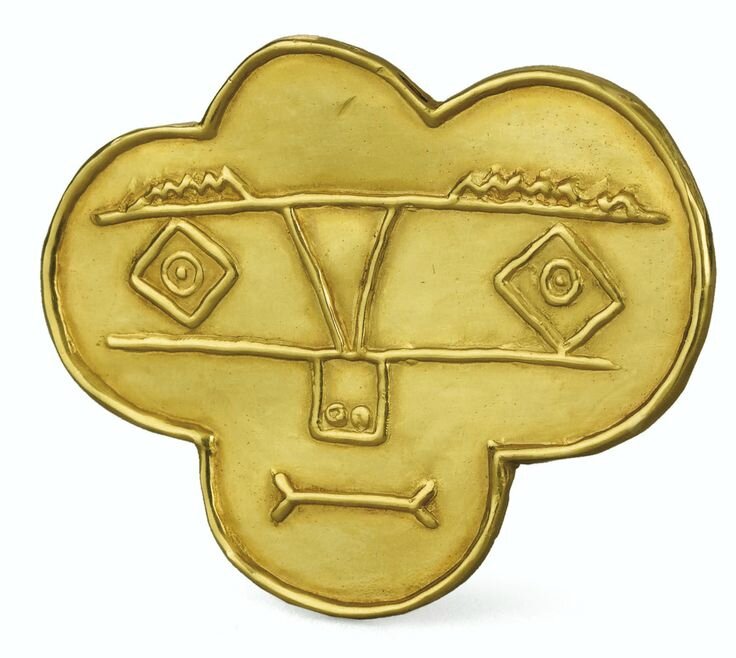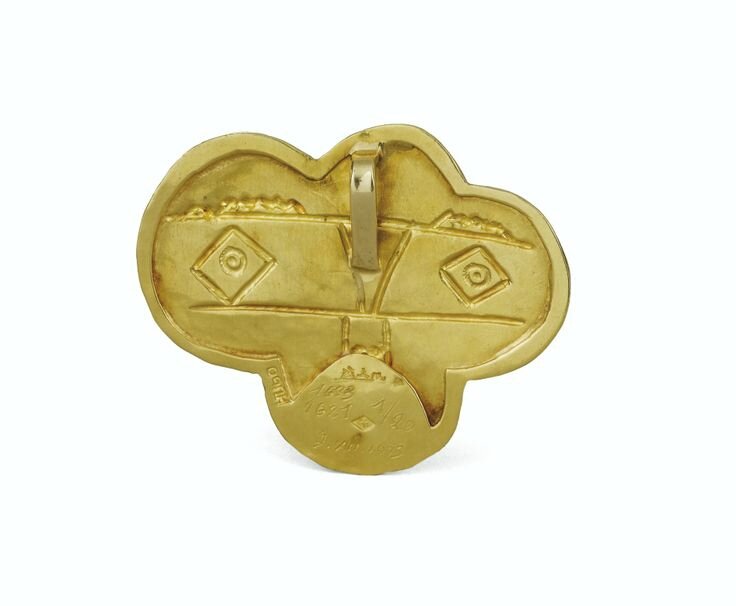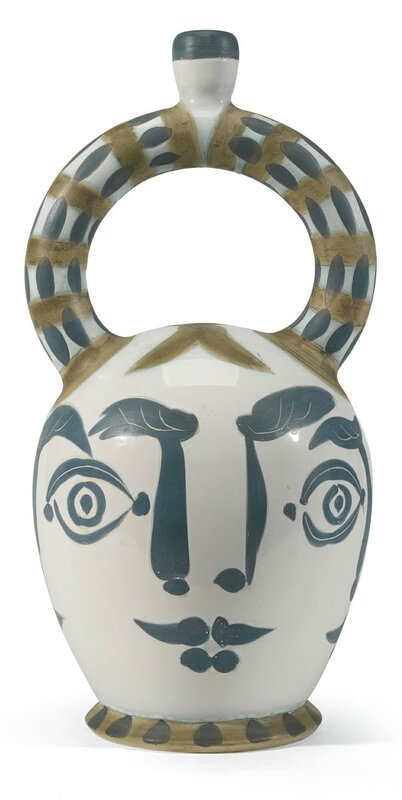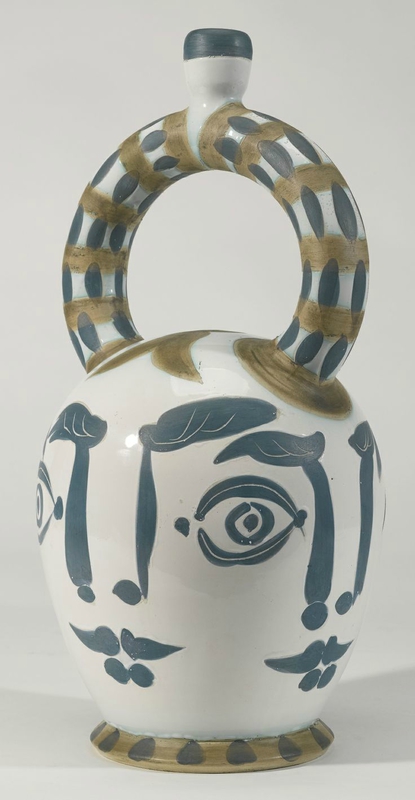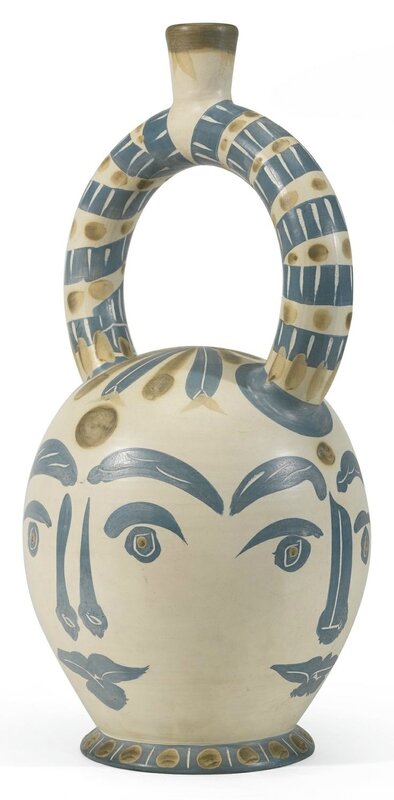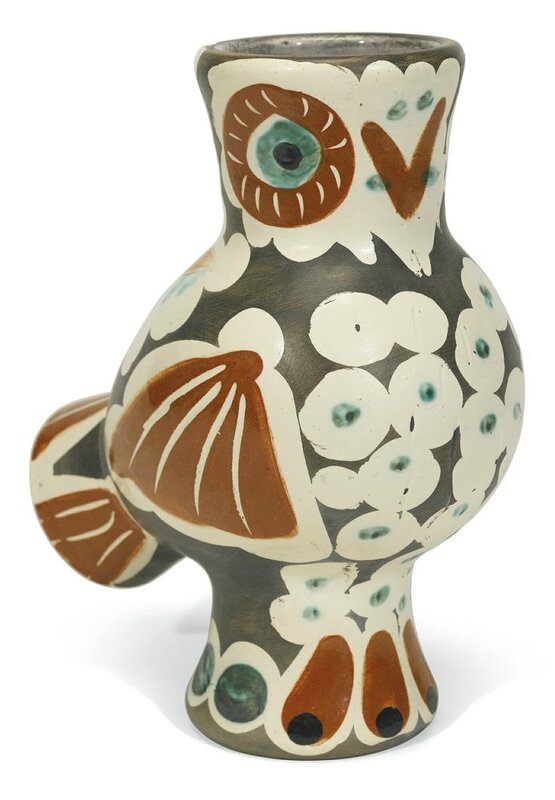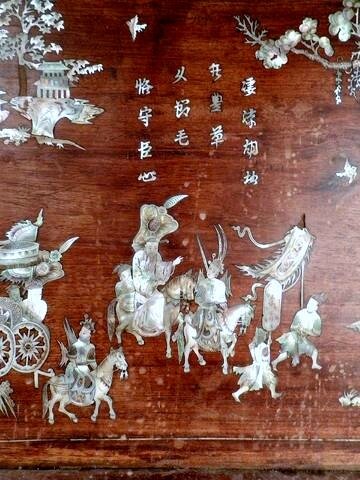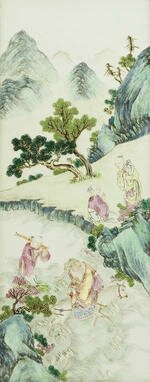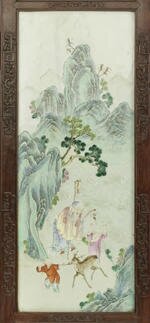Compare the present lot to a vase of similar form and glaze quality, referred to as a Guanyin Zun, illustrated inCatalogue of a Special Exhibition of Ch'ing-Dynasty Monochrome Porcelains in the National Palace Museum, Taipei, 1981, p. 35, no. 1.
Also see a fine example which sold at Christie’s, Hong Kong, 27 November 2013, lot 3487.
![95414102]()
A rare pair of famille rose enamelled 'basket weave' dishes, 18th century. Estimate: £15,000–20,000. Photo: Christie's Images Ltd 2014.
Each dish is of shallow flaring form with a foliate rim. The interiors are elegantly decorated with blossoming peony, chrysanthemum and magnolia flowers and foliage. The rims are delicately moulded with a band of basket weave design. 6 ¼ in. (16 cm.) diam.
Fine Chinese Ceramics and Works of Art: 13 May at 11.30am (Lot 130-230) & 2.30 pm (Lot 231-487) Christie’s King Street, Bid via Christie’s LIVETM
The Fine Chinese Ceramics and Works of Art sale at Christie’s on 13 May features over 350 stellar examples of high quality works, many of which are offered fresh to the market and many from important private collections, with long established notable provenance. The sale presents works dating from the Shang Dynasty (circa 1600-1100 B.C.) through to the 20th century, spanning a wide array of media including ceramics, jade and hardstone carvings, painting and furniture. With attractive estimates ranging from £2,000 up to £300,000, the sale is expected to realise in excess of £5.5 million.
The rich offering of porcelain is led by The Andrew Look Collection which comprises 40 lots of Daoguang Imperial Porcelain (1821-1850) (lots 300-339). Mr Look will be donating a portion of the proceeds from the sale to St James’ Settlement, Hong Kong: http://www.sjs.org.hk/en/intro/mission.php. He is also planning to set up a scholarship to fund students who cannot afford higher education. A very successful strategist and analyst in the financial sector in Hong Kong and also the author of two best-selling non-fiction books, Andrew Look owes his initial interest, as a collector, in Daoguang porcelain to his grandfather Lo Yuk Tong. In the early years of 1942 his grandfather bought a vase from one of his tenants, in order to provide the tenant with enough funds to enable him and his family to leave Hong Kong. Lo Yuk Tong was not himself an art collector, and when his grandson was still a young boy he gave him the vase. It was a Daoguang vase of fanghu shape with Guan-type glaze, and both the beauty of the vase and the story of how it entered his grandfather’s possession inspired the boy. From a young age Look appreciated both the fine aesthetic qualities and the technological merits of porcelains of this period.
In the 1970s and 1980s few collectors were interested in later Qing porcelains, and so Look was able to find good examples in the antique shops on Hollywood Road, where he would spend his laisee money (利是, in Mandarin lishi, or hongbao 紅包 red packet money). He collected some 30 to 50 pieces before leaving Hong Kong to study. Returning in 1986, Andrew Look resumed his searches on Hollywood Road. He was able to train his collector’s eye by attending evening courses in antique appreciation run by Mr. Ho Ping-chung at Hong Kong University, until Ho Ping-chung left Hong Kong for Singapore. It is generally agreed that the reign of Tao Kuang [Daoguang] saw the last porcelains of truly imperial quality. Although fewer imperial porcelains were made during the Daoguang reign than, for example, during the reign of the Qianlong Emperor, it is clear that no expense was spared in their production, and quality remained high, with wide ranging designs, reflecting both the artistic and technological developments of the high Qing, and the specific interests of the Daoguang period.
Highlights from his collection include a pair of famille rose coral-ground ‘peony’ bowls (estimate: £30,000-50,000); a rare pair of doucai floral bowls (estimate: £40,000-60,000); and a pair of finely painted and inscribed famille rose ‘three rams’ bowls (estimate: £25,000-35,000).
![2]()
A pair of famille rose coral-ground ‘peony’ bowls, Daoguang six-character seal marks in underglaze-blue and of the period (1821-1850). Estimate: £30,000-50,000. Photo: Christie's Images Ltd 2014.
Each bowl is potted with deep rounded sides raised on a short foot, with the exterior elaborately decorated with three yellow-ground cartouches containing pink peony flowers, surrounded by further colourful floral sprays and associated foliage, all reserved on a coral ground. 4 ? in. (11 cm.) diam.
Provenance: Christie's New York, 26 March 2010, lot 1442.
Notes: The design of flowers enclosed in cartouches first appeared on falangcai wares of the Kangxi period (1662-1722). An example of a Kangxi mark and period bowl decorated in this style is in the Palace Museum in Beijing, illustrated in The Complete Collection of Treasures of the Palace Museum - 39 - Porcelains with Cloisonne Enamel, p. 4, pl. 2.
Compare the present lot to a Daoguang bowl included in the Exhibition of the Wonders of the Potter's Palette, Hong Kong Museum of Art, 1984, illustrated in the Catalogue, no. 104; and another from the Simon Kwan Collection, included in the Exhibition of Imperial Porcelain of Late Qing, Chinese University of Hong Kong, 1983, Catalogue, no. 51. See a very similar bowl sold at Christie's Hong Kong, 1 June 2011, lot 3737.
![8d3ee35df1c45a0b9ccf7f6d65026295 (2)]()
A rare pair of doucai floral bowls, Daoguang six-character seal marks in underglaze-blue and of the period (1821-1850). Estimate: £40,000-60,000. Photo: Christie's Images Ltd 2014.
ach bowl is potted with deep sides rising to a flaring rim, with the exterior intricately decorated with roundels of fruiting trees separated by branches of pomegranate, above a lappet border around the foot. 6 in. (15.2 cm.) diam.
Provenance: The Yip Family Collection.
Christie's New York, 24-25 March 2011, lot 1716.
Notes: Bowls with this design are based on Kangxi period (1662-1722) prototypes, such as one in the collection of the Palace Museum in Beijing, illustrated in The Complete Collection of Treasures of the Palace Museum - 38 - Porcelains in Polychrome and Contrasting Colours, Hong Kong, 1999, p. 216, no. 197. A Daoguang mark and period example of the same size, shape and decoration is illustrated by G. Avitabile, From the Dragon's Treasure, London, 1987, p. 52, no. 56.
Among the notable porcelain elsewhere in the sale, the cover lot is a rare and finely enamelled pair of famille rose jars and covers, Daoguang period (1821-1850) which are from the Property of a Distinguished Swiss Family having been acquired in Paris in the early 1950s (estimate: £100,000-150,000). The current pair of jars and covers are exceptionally well decorated and rare. No other identical examples are known to date. The decoration is perfectly balanced with the ideal amount of white-ground on each vase, in order to highlight the softness of the enamels. Peonies, hibiscus, begonia, chrysanthemums and asters are depicted growing naturally in a garden, with the details carefully rendered in vibrant colours. Begonias have inspired Chinese craftsmen since the Tang dynasty, providing both shapes and decoration and are specially well-painted in the current jars. The hibiscus and peony provide a rebus for: ‘May you have splendour, wealth and honour’. The depiction of motifs in a continuous scene between coloured-grounds contoured by ruyi-heads appear to be much favoured on Daoguang famille rose porcelains.
![1]()
![95414102]()
A rare and finely enamelled pair of famille rose jars and covers, Daoguang period (1821-1850). Estimate: £100,000-150,000. Photo: Christie's Images Ltd 2014.
Each jar is delicately potted with gently rounded sides, supported on a short, straight-cut foot. The exterior is finely enamelled with blossoming branches of peonies, hibiscus, begonias, chrysanthemums, and asters growing from crumps of vegetation, all between a lappet band at the foot and a ruyi band at the shoulder. The short neck and cover are enamelled with lotus blooms borne on leafy scrolls, all reserved on a fine pink-enamelled ground. The small finial is finely decorated in gilt emulating a chrysanthemum bloom. 7 ½ in. (19 cm.) high
Provenance: With Collection Heliot Fils, 34 Rue de Berlin, Paris.
Acquired in Paris in the early 1950s
Notes: The current pair of jars and covers are exceptionally well decorated and rare. No other identical examples are known to date.
The decoration is perfectly balanced with the exact amount of white-ground on each vase, in order to highlight the softness of the enamels. Peonies, hibiscus, begonia, chrysanthemums and asters are depicted growing naturally in a garden, with the details carefully rendered in vibrant colours.
Begonias have inspired Chinese craftsmen since the Tang dynasty, providing both shapes and decoration and are specially well-painted in the current jars. The hibiscus and peony provide a rebus for : 'May you have splendour, wealth and honour'.
The depiction of motifs in a continuous scene between coloured-grounds contoured by ruyi-heads appear to be much favoured on Daoguang famille rose porcelains. Refer for example to several Daoguang period vases painted around with reticulated scenes comprising various floral motifs, from the Beijing Palace Museum and illustrated in Porcelains with Cloisonne Enamel Decoration and Famille Rose Decoration, The Complete Collection of Treasures of the Palace Museum, Hong Kong, 1999, no. 192.
Furthermore, see also a pair of very finely enamelled jars and covers, bearing Daoguang seal marks and of the period, sold at Christie's Hong Kong, The Yiqingge Collection of Chinese Ceramics, 29 May 2013, lot 2025.
A further important porcelain is a rare large Ming-style blue and white ‘lotus bouquet’dish, Qianlong six-character seal mark in underglaze-blue and of the period (1736-1795), from the Property of a Private European Collector (estimate £100,000-120,000). It is modelled after blue and white ‘lotus bouquet’ dishes from the Ming period. Such dishes with lotus designs belong to an important group of early Ming wares together with ‘grape’ dishes, ‘melon’ dishes and ‘dragon’ dishes. It is rare to find a Qianlong marked dish with this design, as it is more common to find these blue and white ‘lotus bouquet’ dishes with Yongzheng marks.
![95414281]()
A rare large Ming-style blue and white ‘lotus bouquet’dish, Qianlong six-character seal mark in underglaze-blue and of the period (1736-1795). Estimate: £100,000-120,000. Photo: Christie's Images Ltd 2014.
The interior of the dish is finely painted in cobalt blue with simulated 'heaping and piling' to depict a bouquet of lotus and other auspicious plants tied with a fluttering ribbon. The cavetto is decorated with eight large flower heads interspersed with smaller flowers and leafy scrolls, below an everted rim painted with stylised foliage. The exterior is similarly decorated with flowers and leafy scrolls. 16? in. (41.1 cm.) diam.
Notes: The present dish is modelled after blue and white 'lotus bouquet' dishes from the Ming period. Such dishes with lotus designs belong to an important group of early Ming wares together with 'grape' dishes, 'melon' dishes and 'dragon' dishes. J. A. Pope discusses the thirty-four 'bouquet' dishes of varying size and with varying borders in the Ardebil Collection, showing the wide range of intensity of the cobalt blue and the diversity of decoration, see Chinese Porcelains from the Ardebil Shrine, Washington, D.C., 1956, p. 92. Some of these variations can be seen, ibid., on pls. 30 and 31. Several examples of 'lotus bouquet' dishes dating to the Yongle period (1403-1424) were previously sold at auction, including one at Christie's New York, 19 March 2009, lot 711; and one at Christie's Hong Kong, 27 May 2009, lot lot 1804.
It is rare to find a Qianlong marked dish with this design, as it is more common to find these blue and white 'lotus bouquet' dishes with Yongzheng marks.
Among the jades and hardstones featured, the most valuable lot is a large and impressive finely-carved celadon and russet jade ruyi sceptre, 18th century, which was formerly from a private French collection, circa 1960 (estimate: £200,000-300,000). The inscription reads Chen Xu Da Gong Zhu, which can be translated as 'With blessings from your lowly servant Xu Da'. This would suggest that the present sceptre was commissioned as a tribute to the Emperor by one of his subordinates, Xu Da. A sceptre of this nature is very rare, not only due to the sheer size of the boulder required to carve it, but also due to the exceptional pale stone and the outstanding quality of the carving and polish. The ruyi sceptre has been a longstanding auspicious symbol in Chinese art and came into particular fashion within the Qing dynasty when it was often used as a gift to the Emperor on his birthday. This sceptre further conveys feelings of good fortune as it is finely carved with a multitude of auspicious fruits and symbols. The peach, finger citron and pomegranate represent the ‘Three Abundances’, Sanduo and allude to a prosperous long life with many sons. The bat, fu refers to wealth and riches and is a homophone to the character fu, meaning good fortune and happiness. Bamboo, zhu, combined with peaches, tao, are often used as a birthday greeting indicating longevity, immortality and flexibility.
![181635136]()
A large and impressive finely-carved celadon and russet jade ruyi sceptre, 18th century. Estimate: £200,000-300,000. Photo: Christie's Images Ltd 2014.
The large ruyi head terminal is carved in relief with a bat in flight beside two peaches and bamboo branches. The tapering serpentine shaft is carved with pomegranates and finger citron branches between narcissus and lingzhi sprays. The reverse is incised with two bats amongst cloud scrolls and a five-character inscription. The stone is of an even celadon tone with some scattered russet inclusions. 18 ¾ in. (47.6 cm.) long
Provenance: Formerly from a private French collection, circa 1960
Notes: The inscription reads Chen Xu Da Gong Zhu, which can be translated as 'With blessings from your lowly servant Xu Da'. This would suggest that the present sceptre was commissioned as a tribute to the Emperor by one of his subordinates, Xu Da.
A sceptre of this nature is very rare, not only due to the sheer size of the boulder required to carve it, but also due to the exceptional pale stone and the outstanding quality of the carving and polish. The ruyi sceptre has been a longstanding auspicious symbol in Chinese art and came into particular fashion within the Qing dynasty when it was often used as a gift to the Emperor on his birthday. The current sceptre further conveys feelings of good fortune as it is finely carved with a multitude of auspicious fruits and symbols. The peach, finger citron and pomegranate represent the ‘Three Abundances’, Sanduo and allude to a prosperous long life with many sons. The bat, fu refers to wealth and riches and is a homophone to the character fu, meaning good fortune and happiness. Bamboo, zhu combined with peaches, tao are often used as a birthday greeting indicating longevity, immortality and flexibility.
For a sceptre with comparable auspicious decoration and the same elegant curvature to the shaft see Auspicious Ju-I Sceptres of China, National Palace Museum, Taipei, 1995, p. 101, no. 28.
Also compare to a sceptre which is similarly decorated with the 'Three Abundances', sanduo, sold at Christie's, Hong Kong, 30 May 2006, lot 1598.
For an example of a sceptre of related form and colour from the Lizzadro Collection, see Christie's, New York, 21 March 2013, lot 872.
From the Property of a Lady comes a large and finely carved white jade ‘peach and bat’ group, Qianlong period (1736-1795) (estimate: £30,000-50,000). The superb quality of the carving exemplifies the high level of craftsmanship achieved by the jade carvers working under the reign of the Qianlong Emperor. The subject of peaches and bats is very popular in art of the Qing period as it is imbued with auspicious connotations. As peaches denote longevity and bats signify happiness, imagery combining peaches and bats represent the blessing ‘may you possess both longevity and happiness’.
![b9eaffaa3a318c9d5f8df3b7b24e4718]()
A large and finely carved white jade ‘peach and bat’ group, Qianlong period (1736-1795). Estimate: £30,000-50,000. Photo: Christie's Images Ltd 2014.
The stone is finely carved in the form of a large peach with two smaller peaches and foliage beside it. There are two bats with outstretched wings resting on the fruits. The jade is of an even tone with russet inclusions. 5 in. (12.7 cm.) wide
Notes: The present jade carving is notable for its large size and finely rendered details. The superb quality of the carving exemplifies the high level of craftsmanship achieved by the jade carvers working under the reign of the Qianlong Emperor. The subject of peaches and bats is very popular in art of the Qing period as it is imbued with auspicious connotations. As peaches denote longevity and bats signify happiness, imagery combining peaches and bats represent the blessing ‘may you possess both longevity and happiness’.
Collected over more than 50 years, Property from a Private Asian Collection (lots 173-211) presents 38 tourmaline lots, comprising an impressive array of snuff bottles, pendants and other small jewel-like carvings that showcase the wide variety of colours that can be seen in this hardstone, ranging from vibrant pink and lavish purple to lavender blue and emerald green. The incredible skill of the carver is particularly evident in pieces known as ‘watermelon’ tourmaline, which refers to carvings taken from a cross-section of tourmaline naturally formed with a pink centre and an outer green layer. In these pieces the carver cleverly utilises the contrast between the two colours to define separate features of the depicted subjects. This is demonstrated by a 19th century green and pink tourmaline belt hook, carved to depict a crouching chilong grasping a lingzhi branch in its mouth facing a dragon head; the stone of an attractive pale pink tone, shading to a dark green (estimate: £10,000-15,000). Other charming works include a large 19th century model of an elephant in an attractive and even bright pink tone (estimate: £8,000-12,000). In contrast to orthodox views, recent scholarship has indicated that tourmaline carvings were not only made during the late Qing Dynasty or Republic period, but also produced earlier during the 18th and 19th centuries.
![cb802cd28a812a3326c9d34233e89077]()
A green and pink tourmaline belt hook, 19th century. Estimate: £10,000-15,000. Photo: Christie's Images Ltd 2014.
The belt hook is carved to depict a crouching chilong grasping a lingzhi branch in its mouth, facing a dragon head. The curved shaft is later mounted with an inlaid metal fitting. The stone is of an attractive pale pink tone, shading to dark green. 3 ½ in. (8.9 cm.) wide
![ebb874c9bebc0ab4e6b2a5a0a8ab09f2f3c8484f66a6a8b7032490a5dfc8cf0d]()
A large pink tourmaline model of an elephant, 19th century. Estimate: £8,000-12,000. Photo: Christie's Images Ltd 2014.
The recumbent beast is carved with the legs tucked under the body and its trunk curled to one side. The stone is of an attractive and even bright pink tone. 3 ½ in. (8.8 cm.) long.
A small private collection of 19 Mughal style jades from a Private European Collection, collected in the 1970s and 1980s, present mostly celadon and some spinach jades. It is unusual to find a western collection focused on Mughal style jades. The group includes a deep and finely carved and pierced Mughal-style pale celadon jade floral bowl of a semi-translucent stone, 18th/19th century (estimate: £25,000-40,000) and an elegant 19th century Mughal-style pale celadon jade wine pot and cover, elaborately carved with stylised scrolling leaves (estimate: £10,000-15,000).
![Nouveau Dessin OpenDocument]()
A Mughal-style white jade ‘Chrysanthemum’ bowl and cover, 18th-19th century. Estimate: £25,000-40,000. Photo: Christie's Images Ltd 2014.
The bowl is intricately carved in the form of a chrysanthemum flower, with a pair of handles each shaped as a flower bud to either side. The cover is similarly decorated with overlapping petals, surmounted by a purple semi-precious stone secured with a gilt-bronze band. 6 ? in. (17.5 cm.) wide.
Provenance: Formerly from a private American collection, amassed in the first half of the 20th century
![Nouveau Dessin OpenDocument1]()
A Mughal-style pale celadon jade wine pot and cover, 19th century. Estimate: £10,000-15,000. Photo: Christie's Images Ltd 2014.
The wine pot is of a compressed globular form, with a foliate handle with three loose rings opposite a long spout, supported on a short foot carved as an open-form flower. The exterior is elaborately carved with stylised scrolling leaves. There is a pair of smaller handles with loose rings at the shoulder. The jade is of a pale tone with snowy flecks, with the finial of the cover and the handle of the pot embellished with red stones. 8 ½ in. (21.6 cm.) wide.
Provenance: Sotheby's London, 28 October 1988, lot 316
Reflecting the continually growing demand for huanghali furniture and building on the success of the last sale, furniture highlights include an impressive huanghuali altar table of a rich and warm light honey tone, qiaotouan, Ming dynasty, 17th century, which is offered from the Property of a Distinguished Swiss Gentleman (estimate:£200-300,000). A rare and important ‘dragon and phoenix’ huanghuali mirror stand, wupingfengshijingtai , Ming dynasty, 17th century is an example of the mirror stands which were placed on dressing tables for ladies, with the mirrors standing against the central panel and held up with a U-shaped support; cosmetics and ornaments were stored in the drawers located to the lower front (estimate: £40,000-60,000).
![Nouveau Dessin OpenDocument2]()
An impressive huanghuali altar table, qiaotouan, Ming dynasty, 17th century. Estimate:£200-300,000. Photo: Christie's Images Ltd 2014.
The long solid rectangular top is set with everted scroll form ends above a shaped apron with stylised taotie masks at each corner. The square section legs, of slightly tapering and flaring form, support an open-work carved panel at each end, depicting mythical dragon-form beasts. The wood is of a rich and warm light honey tone. 92 ¼ in. (234.3 cm.) wide, 37 ¾ in. (96 cm.) high, 15 ? in. (39.8 cm.) deep
Provenance: With Compagnie de la Chine et des Indes, Paris, 3 February 2003
Notes: Nowadays this form is called by its descriptive name qiaotouan, or "everted end recessed leg table," but the late Ming style-maker Wen Zhenheng termed it bizhuo, or "wall table," as it was commonly used against a wall to display works of art or to hold offerings.
The current table is a remarkable example of late Ming furniture, not only because of the fine and precise workmanship, but also due to its perfectly balanced dimensions and fine timber used in its construction.
Various examples of similar tables are published, where the openwork panels at the ends are very finely carved with dragons, phonenix and other mythical creatures. See for example a jichimu qiaotouan formerly from the Museum of Classical Chinese Furniture Collection illustrated in Wang Shixiang et al., Masterpieces from the Museum of Classical Chinese Furniture, Hong Kong, 1995, pp. 112-3, no. 53, and sold at Christie's New York, 19 September 1996, lot 59; and again at Sotheby's New York, 14 September 2011, lot 126. Compare also a qiaotouan with phoenix spandrels exhibited in at the Hong Kong Museum of Art, In Pursuit of Antiquities, Thirty Fifth Anniversary Exhibition of the Min Chiu Society, Hong Kong, 1995, illustrated in the Catalogue, no. 242; and a pingtoauan with phoenix spandrels illustrated by G. Wu Bruce, A Choice Collection, Chinese Ming Furniture, Hong Kong, 2011, pp. 98-99. A huanghuali table in the Minneapolis Institute of Arts with more elaborately carved phoenix spandrels is illustrated by R. Jacobsen and N. Grindley in Classical Chinese Furniture in the Minneapolis Institute of Arts, Minneapolis, 1999, no. 42.
Refer to S. Handler's article, "Side Tables, a Surface for Treasures and the Gods," in Chinese Furniture: Selected Articles from Orientations, 1984-1999, Hong Kong, 1999, pp. 200-9, where she discusses the role of this type of table, both as a side table as well as a domestic altar table.
![Nouveau Dessin OpenDocument4]()
A rare and important ‘dragon and phoenix’ huanghuali mirror stand, wupingfengshijingtai , Ming dynasty, 17th century. Estimate: £40,000-60,000. Photo: Christie's Images Ltd 2014.
The top of the crest rail is decorated with a flaming pearl and is flanked by dragon-head terminals, above five openwork panels intricately carved and pierced with sections of dragons and phoenix, all with dragon-head terminals to the top corners. The central curved panel to the front is finely carved with a dragon chasing the flaming pearl above crashing waves. The lower front is set with five drawers detailed with cartouches of phoenix in flight, below a balustrade carved with reticulated panels of mythical beasts and surmounted by finials carved with dragons, all raised on short straight legs. 31¾ in. (80.7 cm.) high, 20? in. (53 cm.) wide, 13? in. (34 cm.) deep.
Provenance: Acquired in China by a noble Austro-Hungarian gentleman in the early 20th century and thence by descent to the current owner.
Notes: The structural design of mirror stands is based on floor screens with inset panels and fixed bases. These mirror stands were placed on dressing tables for ladies, with the mirrors standing against the central panel and held up with a U-shaped support. Cosmetics and ornaments were stored in the drawers located to the lower front. See a similar mirror stand, formerly in the collection of the Museum of Classical Chinese Furniture, published by C. Evarts in 'The Classic of Lu Ban and Classical Chinese Furniture,' JCCFS, Winter 1993, p. 41, fig. 19, and in Wang Shixiang and Curtis Evarts.Masterpieces from the Museum of Classical Chinese Furniture, Chicago and San Francisco, 1995, p. 148, no. 70, and sold at Christie's, New York, 19 September 1996, lot 56. Another example is illustrated in the exhibition catalogue,Chinese Hardwood Furniture in Hawaiian Collections, Honolulu Academy of the Arts, 16 January - 14 February 1982, p. 64, no. 46. Several mirror stands were sold at Christie’s, including one sold at Christie's Paris, 19 December 2012, lot 106; one sold at Christie's New York, 16 - 17 September 2010, lot 1209; and one sold at Christie's Los Angeles, Myth and Reality: Animals in Chinese Art, 7 May 1999, lot 93.
Further notable pieces include a large 19th century huanghuali and hardwood cabinet, fangjiaogui, which is among the Property from the Collection of Mr. Cheng Huan, Q.C., S.C. (lots 457-459 & 475) (estimate: £30,000-50,000). Christie’s is delighted to offer this selection of Chinese works of art from the collection of Mr Cheng Huan S.C., which has been kept at Stockton House in Wiltshire, England, for many years. Mr Cheng has close ties with China, where he is a member of the Peoples’ Consultative Conference for the Province of Fujian, and also Hong Kong, where he is a well-known advocate, an Adjunct Professor at City University and Director of the Chinese Overseas Friendship Association. He began collecting Chinese works of art over forty years ago and bought from reputable London dealers including Spink and Son Ltd. and at major auction houses including Christie’s.
![Nouveau Dessin OpenDocument5]()
A huanghuali and hardwood cabinet, fangjiaogui, 19th century. Estimate: £30,000-50,000. Photo: Christie's Images Ltd 2014.
The rectangular-shaped cabinet has a pair of hinged doors to the front with circular brass lock plates. The interior has two draws and a hidden compartment to the base. The wood is of an attractive light brown tone. 78 in. (198.2 cm.) high, 59 ¼ in. (150.3 cm.) wide, 30 ¼ in. (76.6 cm.) deep.
Property from the Collection of Mr. Cheng Huan, Q.C., S.C.
Further to the success of the paintings which were offered in the London sale in autumn 2013, this season’s offerings are led by Boat in a Mountainous Landscape, 1964, by Fu Baoshi (1904-1965) which is offered for the first time in over 40 years from a Private English collection (estimate: £100,000 - 150,000). A hanging scroll, executed in ink and colour on paper, it is inscribed and signed with two seals of the artist. Providing opportunities across different price levels of the market, the sale also includes a set of nine etchings from palaces, pavilions and gardens created by Giuseppe Castiglione in the Imperial Ground at Yuanming Yuan at the Summer Palace, Beijing (estimate: £10,000 – 15,000). These engraved plates after Castiglione are printed on vélin de Rives. The original etchings were created between 1783 and 1786 for the Emperor Qianlong and portray the edifices, gardens and palace grounds constructed from 1737 to 1766 and painted by the Jesuit missionary to the Chinese court, Guiseppe Castiglione known as Lang Shining.
![Nouveau Dessin OpenDocument6]()
Fu Baoshi (1904-1965), Boat in a Mountainous Landscape, 1964. Estimate: £100,000 - 150,000. Photo: Christie's Images Ltd 2014.
Ink and colour on paper, hanging scroll. Inscribed and signed with two seals of the artist. Dated 1964. 19 x 13 in. (48 x 33 cm.)
Provenance: From a private English collection, late 1960's
![Nouveau Dessin OpenDocument7]()
A set of nine etchings from palaces, pavilions and gardens created by Giuseppe Castiglione in the Imperial Ground at Yuanming Yuan at the Summer Palace, Beijing, 20th century. Estimate: £10,000 – 15,000. Photo: Christie's Images Ltd 2014.
Nine engraved prints after Giuseppe Castiglione printed on vélin de Rives. The original etchings were created between 1783 and 1786 for the Emperor Qianlong and portray the edifices, gardens and palace grounds constructed from 1737 to 1766 and painted by the Jesuit missionary to the Chinese court, Guiseppe Castiglione, known as Lang Shining. Each print measures 21 x 35 in. (53 x 89 cm.) framed.
Chinese Ceramics, Works of Art and Textiles: 14 & 16 May, both at 10.00am & 2.00 pm, Christie’s South Kensington - Bid via Christie’s LIVETM
This season, Christie’s South Kensington will introduce a new sale format during Asian Art week at Christie’s in London, which will be repeated in London in November and beyond: a two-day sale of Chinese Ceramics, Works of Art and Textiles. This sale extends what was previously a one day sale of the same title and replaces the Interiors sale dedicated to Chinese Art, comprising a similar overall number of lots. Increasing, rather than limiting, collecting opportunities across multiple price points and periods, the new sale format on the 14th and 16th May features approximately 750 lots in total, spanning over one thousand years of Chinese art, from the Shang Dynasty (1600 BC) to Republic period (1912-1949). The sale offers a strong array of porcelain, jade and other hardstones, cloisonné enamel, bronzes, snuff bottles, paintings and textiles. Providing established and new collectors with great opportunities to buy quality works with established provenance, estimates range from £1,000 up to £50,000; the sale as a whole is expected to realise in the region of £2.5 million.
The strong selection of jades offered across both days is led by the catalogue cover lot: a pale celadon jade boulder depicting the arhat Angaja, Qianlong period (1736-1795) (estimate: £30,000 – 50,000). The auction presents jades from several private UK, European and Asian collections, including the Collection of Cheng Huan, Q.C., S.C.,which was amassed from the 1970s through to the 1990s and features notable examples of jades from all periods, such as a white jade oval plaque, 18th/19th century (estimate: £6,000-8,000). Further notable examples include a white and russet jade ‘twin geese’ group, Qianlong period (1736-1795) from the Property from an Important Swiss Collection (estimate: £8,000 – 12,000).
![Nouveau Dessin OpenDocument8]()
A pale celadon jade boulder depicting the arhat Angaja, Qianlong period (1736-1795). Estimate: £30,000 – 50,000. Photo: Christie's Images Ltd 2014.
![Sans nom 1]()
A white jade oval plaque, 18th-19th century. Estimate: £6,000-8,000. Photo: Christie's Images Ltd 2014.
![Sans nom 1]()
A white and russet jade ‘twin geese’ group, Qianlong period (1736-1795) from the Property from an Important Swiss Collection. Estimate: £8,000 – 12,000, Photo: Christie's Images Ltd 2014.
The very prominent section of Republic Porcelain reflects the continuing growth of demand for works from this later period (1912-1949). The works offered provide excellent examples of the virtuosity of the Republic period porcelain artists and include two private collections: an American Collection amassed in Hong Kong in the 1940s to 1960s and the Property of a Private Australian Collector, assembled circa 1950 to 1972. After the establishment of the Republic, artists were no longer limited to the formulae previously dictated by Imperial patronage. Highlights include a charming famille rose plaque (estimate: £15,000 – 20,000); a famille rose bottle vase, iron red and gilt Songyun Zhencang mark (estimate: £10,000 – 15,000); a famille rose and en grisaille plaque (estimate: £8,000 – 12,000); and sixteen famille rose plaques (estimate: £3,000 – 5,000), which are the Property of a Private Australian Collector, assembled circa 1950 to 1972.
![Sans nom 2]()
A charming famille rose plaque, Republic period. Estimate: £15,000 – 20,000. Photo: Christie's Images Ltd 2014.
![Sans nom 2]()
A famille rose bottle vase, iron red and gilt, Songyun Zhencang mark. Estimate: £10,000 – 15,000. Photo: Christie's Images Ltd 2014.
The earlier porcelain featured from the Qing dynasty ranges from a blue and white brush pot, bitong, Kangxi Period (1662-1722) (estimate: £15,000-20,000) from the Property of a Private European Collector, to a pair of famille rose coral-ground bowls and covers, Daoguang Period (1821-1850), underglaze blue xiezhu zhuren marks (estimate: £10,000-20,000), which are offered for the first time in over 30 years, having been acquired from Christie’s London in 1983.
![Sans nom 3]()
A blue and white brush pot, bitong, Kangxi Period (1662-1722). Estimate: £15,000-20,000. Photo: Christie's Images Ltd 2014.
From the E.T. Hall Collection Christie’s South Kensington is pleased to offer a further a group of twenty one 18th century monochrome vases, in addition to those in the King Street sale. They include an aubergine-glazed ‘dragon’ dish, incised Qianlong six-character seal mark and of the period (1736-1795) (estimate: £4,000-6,000) and a guan-type vase, hu, 18th century, which was exhibited with the Oriental Ceramic Society, in the Iron in the Fire exhibition, Oxford 1988 (estimate: £3,000-5,000).
![3]()
An aubergine-glazed ‘dragon’ dish, incised Qianlong six-character seal mark and of the period (1736-1795). Estimate: £4,000-6,000. Photo: Christie's Images Ltd 2014.
A stellar group of approximately thirty seven textiles will be offered, with magnificent examples including a brown-ground court robe for an Imperial duke, jifu, 19th century, which is part of the property offered from The Collection of Werner Forman (1921-2010), a London-based Czech award-winning photographer with an extensive and eclectic collection (estimate: £15,000– 20,000) and an Imperial turquoise gauze court robe, jifu, mid-19th century (estimate: £15,000-20,000). Turquoise robes were reserved for Imperial concubines and female members of the Imperial family.
![5]()
A brown-ground court robe for an Imperial duke, jifu, 19th century. Estimate: £15,000– 20,000. Photo: Christie's Images Ltd 2014.
![6]()
An Imperial turquoise gauze court robe, jifu, mid-19th century. Estimate: £15,000-20,000). Photo: Christie's Images Ltd 2014.
Reflecting the breadth and depth of the works at South Kensington this season, further highlights in other mediums include a selection of 20th century Chinese Paintings from two private collections, led by an inscribed and signed ink painting by Yang Yanwen (b.1939), Green Trees at £3,000-5,000 from a private European collection, a 17th century parcel-gilt bronze ‘qilin’ censer from the Collection of Cheng Huan, Q.C., S.C., (estimate: £6,000-8,000) Lot 1036: 42780526; and an order of the Double Dragon gold medal, Type 3, Third class, circa 1900 (estimate: £10,000-15,000). The Order of the Double Dragon was awarded to foreigners for services to the Guangxu Emperor (1875-1908), this particular medal was awarded to Dr. Thomas Laurie Brander, M.D., J.P. for his service to wounded Chinese soldiers during the first Sino-Tibetan War (1894-1895).
![5]()
A parcel-gilt bronze ‘qilin’ censer, 17th century, from the Collection of Cheng Huan, Q.C., S.C. Estimate: £6,000-8,000. Photo: Christie's Images Ltd 2014.
![6]()
An order of the Double Dragon gold medal, Type 3, Third class, circa 1900. Estimate: £10,000-15,000. Photo: Christie's Images Ltd 2014.









